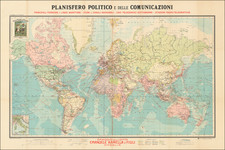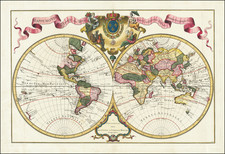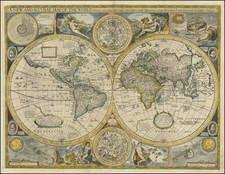The First Modern Anthropological Map – Published by Female Naturalist Marie Masson le Golft
Fine example of Marie Masson le Golft's rare and important anthropological map of the world, first published in Paris in 1787.
The map was designed by Masson le Golft and engraved by Maurille Antoine Moithey (1731-1810), a royal geographer and cartographic publisher.
This map’s title translates as:
Sketch of a general picture of the human race, where one perceives at a glance the religions and customs of the different peoples, the climates in which they live and the main varieties of shape and color of each of them.
It is one of the first maps to employ a visual model for human stadial development and differentiation, making it an important object not only for the history of cartography, but for the history of anthropology as well. Additionally, it was one of the few maps of the eighteenth-century made by a woman.
The double-hemisphere map is surrounded by brilliant rays shooting out from the spheres, heightening the information therein and suggesting that it would enlighten the reader. Between the spheres in the upper section is a cartouche that includes the title topped with a globe and royal and religious headdresses from around the world. Cornucopias surround these objects, suggesting that familiarity with the world’s religions and geography is a fertile field of knowledge. At the lower conjoining of the hemispheres is a pastoral scene of Adam and Eve in the Garden of Eden, a reference to the origin of man, while this map shows the spread of humanity around the world.
The content of the map is of some interest, as it includes a number of recent voyages and cartographic myths. The expeditions of Cook are evident, for example, with the complete outline of New Zealand and the addition of the Sandwich Islands (Hawai’i), as well as Cook’s farthest southern latitude in a dotted line that rings the South Pole. This dotted line indicates the presence of icebergs, as seen by the buccaneer Edward Davis in 1680. The myths include a by-then anachronistic Mer de l'Ouest (Sea of the West) and a conjectural Lac de Fuentes and Lac de Velasco.
In the Eastern Hemisphere, Australia is connected to Tasmania, as it was understood to be by Europeans until Van Diemen’s Land (Tasmania) was circumnavigated by Matthew Flinders and George Bass in 1798-9. New Guinea is only partially delineated, with an open coastline to the east. Jesso (Hokkaido) appears nearly attached to mainland Asia, with the phantom Isle des Etats (Staten Land, actually one of the Kuril Islands) to the east.
Each of the hemispheres are surrounded by a ring denoting latitude, but also by an additional partial ring. In the Eastern Hemisphere is a half-circle that explains how many hours of sunlight each latitude enjoys at the summer solstice; at the poles, the number of months each latitude has complete daylight is indicated. In the Western Hemisphere, the half-circle shows the latitudinal extent of each climactic zone: polar, temperate, and torrid. These were thought to have an effect on human development and appearance.
The most interesting additions to the map, however, are symbols explaining Masson le Golft’s identification of categories of human difference. The categories under examination include the following, from left to right in the lower left and right corners of the map:
Religion: Catholic, Christians separated from the Church [Protestants and Orthodox Christians]. Mahometans (without distinction by sect, Masson Le Golft adds in the text at the bottom of the map) [Muslims], Idolaters (including pagans)
Customs: Learned, Living in society, Savage, Polygamous, Nude, Humane, Cruel
Colors: White, Black, Bronze, Olive, Tan, Yellow
Forms: Small, Medium, Large, Extra-Large, Well-formed, Badly-formed, Beautiful, Ugly
These symbols are applied to groups of people all over the map. Certain groups can have many symbols applied to them. For example, Madagascans are marked as idolaters, Muslims, nude, polygamous, living in society, large, well-made, and humane.
Running along the bottom of the map is a four-column block of text that explains the methodology used to design the map and its system of symbols. In this pedagogical tool, Masson le Golft reveals herself to be a monogenesist, believing in one common descent for all humans, although she thinks that certain groups have degenerated from the common model, which she says came from Armenia.
In this text, certain biases of the author become apparent, with Catholicism put forward as the default religion, for example, or with white people as the most civilized and least-degenerate of human kind. While the cartographic modelling of such information was novel, similar ideas were unfortunately not unique in the eighteenth-century. Indeed, this extraordinary map is a fine example of Enlightenment stadial theory and the Eurocentric theories of human differentiation and development then current in Enlightenment circles.
In other writing, Masson le Golft explained the importance of teaching geography to young girls. As a corresponding member of the Cercle des Philadelphes, based in Cap Francois, Saint Domingue (modern Haiti), she advocated for the education of Creoles, especially Creole girls, although not for enslaved children. With a firm grasp on geography, young educated ladies could act as a civilizing force in the home.
Enlightenment rationality and human variation: the emergence of race
The Enlightenment was an intellectual movement whose adherents considered the application of reason, rather than religious doctrine or received wisdom, to be the most effective method to discern or reveal knowledge. Often, this movement is thought of as a turn toward science from superstition, toward the embrace of equality and order rather than exclusive, rigid hierarchies. However, the Enlightenment created its own hierarchies, re-establishing supremacy of privileged white men over the poor, women, and non-Europeans.
Indeed, the discussion surrounding skin color and differences in customs of peoples from around the world would, by the nineteenth century, harden into our modern scientific understanding of race. Enlightenment values of rationality and equality were used both to construct scientific racial categories, but they also planted the seeds of resistance against such categories.
The strategies of classification favored by natural philosophers like Linné, Buffon, and later Blumenthal were forerunners of the creation of categories, which could be ranked, that were grounded on physical typology. These empirical categories were based on aesthetic preferences, especially the preference for white skin.
In cartography, categories of physical human difference were often grafted onto geographical locations. For example, the torrid zone, near the equator, was thought by some to change skin color and sap vigor, leaving Europeans who moved there indolent and sickly. Additionally, geography was implicated in theories of development and human history. Stadial theory, the idea that man progresses from hunting and gathering to agriculture to industry, with additional civility conferred at each stage, was conflated with indigenous peoples encountered by Europeans in the early modern period. Therefore, native peoples were often described as savage, a word that could refer to violence, but which also denoted a lack of the trappings of civilization that were considered normal, and inevitable, by Europeans.
When Europeans encountered new groups of people, like the Tahitians, for example, they thought they were meeting an uncorrupted humanity still in a state of nature, without the vexations of the modern world. Conversely, and usually depending on the circumstances of a first encounter, Europeans could consider a group ferocious and cruel, and therefore in need of correction, as was the case with the Māori. These brief encounters were inserted into preexisting intellectual frameworks which were also ranked hierarchies that served to make sense of new information but also to reify white Europeans as dominant in the world.
Early thematic maps
Masson le Golft’s map was an important contribution to the emergence of thematic mapping. A thematic map is one that emphasizes the spatial distribution of a specific feature, be it environmental, social, cultural, etc. Scholars disagree as to which map is the first thematic map, and some say examples come from as early as the Middle Ages. Prior to ca. 1800, however, surviving examples are isolated instances made without awareness of the novelty of the map type. The genre of thematic maps, rather, arose at the end of the eighteenth century and accelerated in use after 1820.
Early examples of thematic maps include the work of Edmond Halley (1656-1742), who created the earliest maps with isolines, as well as an early meteorological chart, an eclipse chart, and a tidal chart. Another early thematic map is the 1665 world map of Athanasius Kircher, showing his hypothesized network of subterranean passages.
In the eighteenth century, more examples proliferated. These include Philppe Buache’s watershed world map (1756) and Marie Masson le Golft’s anthropological map of the world. By the early twentieth century, the works of Alexander Humboldt were causing a stir; he made a diagram to illustrate the distribution of plants at varying elevations, a color-coded profile of the earth’s crust, and a geological map of the earth. By the mid-nineteenth century, thematic maps were a typical tool in many branches of science and were increasingly seen in the public sphere.
Rarity
The map is very rare, with OCLC listing only four institutional examples at the National Museum of Natural History (Paris), the Bibliotheque Nationale de France, the Clements Library, and the Sachsische Landesbibliothek (Dresden).
This is the first time we have offered the map in over thirty years of trading.
Text at bottom of map
This pamphlet must be considered as the outline of a general plan of which I propose to give developments [make updates]; this is why we do not find in it all the details of which it might be susceptible.
It suffices for it to fulfill the main object, for it to indicate at first glance that the people we want to know occupy such and such a place on the surface of the earth, and in such a climate as it is, or are Catholic or separate from the church, Mahometan or idolater, learned or ignorant, civilized or savage, human or cruel; that those which compose it are white, black or bronzed, olive-colored, tan, or yellowish, small, medium, large, or very large, well or badly made, nude, polygamists, &c. We should not even demand all these details for barely known peoples, since several of our best books, which moreover do not agree, do not reveal more than we find here. Quite strange things are said, sometimes even contradictory things, about white negroes and pious negroes, the Blasards of Darien, the Kaerelas of Asia, the Quinos of Madagacar, the whites of Jesso, the Dondos of Africa, the Albinos & c. &c. and all this is too accidental or too uncertain to find a place in this sketch. One also confuses tan or olive with bronze, or yellow with tan and olive peoples; which is very different for so many, and as to manners it seems that a people is often judged by some individual.
There are exceptions, mixtures of religion, customs, color, &c. caused by migrations of which a general plan is hardly acceptable; I have for such indicated, as when a people is partly Christian and partly idolatrous, put the mark of one and the other &c.
It is about the midway between the Caspian Sea and the Black Sea that the human race took its origin and is renewed, the spirit and the body seem at first glance so far degenerated from this common center (except the European colonies) that we would draw distressing consequences if we did not know, moreover, that a part of the nations which we call savages are hardly so except by the comparison which we make of the ideas which we adopted and of our customs with theirs, because all or almost all recognize a Supreme Being who created all things, believe in the immortality of the soul, distinguish between good and evil, form societies, have some advantageous ideas, esteem themselves more than others, have arts, an intelligence and discernment, which would often do honor to civilized man.
Those which appear to have the least degenerate form and color in general and ,with a few exceptions, are the least distant from the place where it appears that Adam was placed; this is what we call Armenia; such are the Armenians, the Georgians, the Mingreliens, the Circassians, the Kashmirians, some Tartars and Moguls, the Persians, the Arabs, the Egyptians, the Turks, the Greeks, the Italians, the Spaniards, the French, the Germans, the Polish, Russians, Swiss, Danes, English & c. Northern Europe and northern and eastern parts of Asia, almost all of Africa and America offer men whose color has more or less degenerated. These Asians and those in North America are olive-skinned, those who live in the new continent between the two tropics or so (I mean the natives) are bronze or red coppery-colored, and in the rest of South America there are men of a yellowish complexion. The Africans if we except the Egyptians and some Barbarians [from the Barbary Coast], are either tan or absolutely black, the latter occupy a triangle whose base extends over the west coast of Africa at about eighteen degrees to the north and to the equator and summit as far as Nubia.
As for religions, I thought I should restrict myself to first making known among Christians those who are Catholics from others, without considering whether the latter are schismatic or heretical in the face of mixtures and that there are a few schismatics who do not err in a few points. 2. The Mohammedans without distinction of sect. 3. The Pagans are also included with the idolaters, paganism being a kind of idolatry and the number of pagans very small.
One might believe that a religion is lacking here, Judaism; but as people who apparently hold this belief are a phenomenon among all the others, wandering, all strangers, without altars, without sacrifices, without a leader, it could not enter into my general plan; we know that there are many in Asia and in Africa, less in Europe, few in America.
The regions inhabited by whites have no color here, everything else is indicated by a light wash, and what concerns religions, customs, and the main varieties of shape are indicated by the marks found on this tableau.
Le Masson le Golft was a French naturalist, scientist and academician, best known for her work Balance de la Nature (1784), in which she evaluated hundreds of animals, plants and minerals and assigned grades to each based on God's "harmonious design." Based in Le Havre, Masson le Golft was not university-educated due to her sex; instead, she learned from the astronomer and naturalist Jacques-Francois Dicquemare, a friend of her fathers who specialized in the study of mollusks.
After Dicquemare’s death in 1789, Masson le Golft spent years trying to publish his tome on shellfish, but the financial constraints of publication were too much to overcome. She also continued her own work, teaching geography, geometry, and drawing and writing works on natural history and education. She corresponded with luminaries like Condorcet and was a corresponding or honorary member of several academies, including the Circle des Philadelphes du Cap-Francois, the Madrid Royal Academy of Education, and the Royal Society of Bilbao.
Her contribution to cartography is a fascinating thematic map that visualizes human difference—one of the first anthropological maps even published. Esquisse d'un Tableau General du Genre Humain (1787) was intended as a teaching tool as well as a visual aid to communicate Masson le Golft’s thoughts on the important topic of human development and differentiation, a popular subject in Enlightenment Europe.









![(World) ЗАПАДНОЕ ПОЛУШАРИЕ | ВОСТОЧНОЕ ПОЛУШАРИЕ [Western Hemisphere | Eastern Hemisphere]](https://storage.googleapis.com/raremaps/img/small/90264.jpg)
![Western Hemisphere | Eastern Hemisphere [2 sheets]](https://storage.googleapis.com/raremaps/img/small/85676.jpg)
![[ Hesiod's World Map ] Hesiodische Welt-Tafel von I.H. Voss](https://storage.googleapis.com/raremaps/img/small/102650.jpg)


